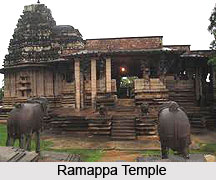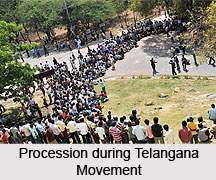 History of Telangana covers with the rich glorious history of the South India. The area which is now called Telangana, a newly formed state in India with capital Hyderabad, was once ruled by Satavahanas, Chalukyas, Kakatiyas, Vatakas and many South Indian dynasties of ancient era. After the decline of Hindu kingdoms, the Muslims began to rule this place and ended with the reign of Nizams, during the regime of British Government.
History of Telangana covers with the rich glorious history of the South India. The area which is now called Telangana, a newly formed state in India with capital Hyderabad, was once ruled by Satavahanas, Chalukyas, Kakatiyas, Vatakas and many South Indian dynasties of ancient era. After the decline of Hindu kingdoms, the Muslims began to rule this place and ended with the reign of Nizams, during the regime of British Government.
Early History of Telangana
Telangana was once ruled by the rulers of Satavahana dynasty. It was from 230 BC to 220 BC, Satavahana kings became the dominant power in the area. It originated from the lands between the Godavari River and Krishna River. After the decline of the Satavahanas dynastical rule, the various dynasties, such as the Vakataka, Vishnukundina, Chalukya, Rashtrakuta and Western Chalukya, ruled the area with the pomp and power.
Medieval History of Telangana
Then came the rule of Kakatiya Dynasty, after the decline of Chalukyas. The Toranas of great architectural beauty was built by the Kakatiyas in Warangal in 1163 AD that is during the time of medieval rule. The Ramappa Temple was built in 1213 by ruler Recherla Rudra of Kakatiyas. Telangana experienced its golden age during the reign of the Kakatiya dynasty. The rulers of Kakatiya dynasty ruled most parts of what is now Andhra Pradesh and Telangana from 1083 to 1323. Ganapatideva, who came to power in 1199, was known as the greatest of the Kakatiya Dynasty. He was famous as after the Satavahanas, brought the entire Telugu area under one rule. He put an end to the rule of the Telugu Cholas, who accepted his suzerainty in the year 1210. He established order in his vast dominion that stretched from the Godavari delta in the east to Raichur, which is known as Karnataka in modern days in the west and from Karimnagar District and Bastar District in the north to Srisailam and Tripurantakam, near Ongole, in the south. It was during the reign of Ganapatideva, the Golkonda fort was constructed. After Ganapatideva, Rudrama Devi and Prataparudra were prominent rulers from the Kakatiya dynasty. The dynasty of Kakatiya weakened with the attack of Malik Kafur in the year 1309 and was dissolved with the defeat of Prataparudra by the forces of Muhammad bin Tughluq in 1323. The area came under the Muslim rule of the Delhi Sultanate in the 14th century, followed by the Bahmani Sultanate. Quli Qutb Mulk, a governor of Golkonda, revolted against the Bahmani Sultanate and established the Qutb Shahi dynasty in 1518. On 21 September 1687, the Golkonda Sultanate came under the rule of the Mughal emperor Aurangzeb after a year-long siege of the Golkonda fort, which is now the tourist attraction site of Telangana.
Modern History of Telangana
 In the year 1748, Telangana saw the political unrest due to contention for the throne among the sons of Asif Jah I. They were aided by opportunistic neighbouring states and colonial foreign forces like French East India Company and British East India Company. In the year 1769, Hyderabad city became the formal capital of the Nizams. Nizam signed a subsidiary alliance in 1799 with British East India Company and lost its control over the state`s defence and foreign affairs. At that time, Hyderabad was known as the Princely State of Hyderabad. Hyderabad became a princely state among the presidencies and provinces of British East India Company. Till 1947, Nizam had the administrative powers. After independence, Nizams transferred the power to the Indian Union. The central government of that time in India appointed a civil servant, M. K. Vellodi, as first chief minister of Hyderabad on 26 January 1950. He administered Hyderabad with the help of English bureaucrats from Madras State and Bombay (Mumbai), who were part of British Indian Government and familiar with the administrative system unlike the bureaucrats of Hyderabad state who used completely different administrative system from British India. From that time, Urdu is known as a state language.
In the year 1748, Telangana saw the political unrest due to contention for the throne among the sons of Asif Jah I. They were aided by opportunistic neighbouring states and colonial foreign forces like French East India Company and British East India Company. In the year 1769, Hyderabad city became the formal capital of the Nizams. Nizam signed a subsidiary alliance in 1799 with British East India Company and lost its control over the state`s defence and foreign affairs. At that time, Hyderabad was known as the Princely State of Hyderabad. Hyderabad became a princely state among the presidencies and provinces of British East India Company. Till 1947, Nizam had the administrative powers. After independence, Nizams transferred the power to the Indian Union. The central government of that time in India appointed a civil servant, M. K. Vellodi, as first chief minister of Hyderabad on 26 January 1950. He administered Hyderabad with the help of English bureaucrats from Madras State and Bombay (Mumbai), who were part of British Indian Government and familiar with the administrative system unlike the bureaucrats of Hyderabad state who used completely different administrative system from British India. From that time, Urdu is known as a state language.
Telangana Rebellion
Telangana Rebellion in that time (after the transfer of power from Nizams to the Indian Union) was a peasant revolt supported by the communists of India. It took place in the former princely state of Hyderabad between 1946 and 1951. It was led by the Communist Party of India (CPI). The revolt began in the Nalgonda district of Andhra Pradesh (now in Telangana) against the feudal lords of Reddy and Velama castes. It quickly spread to the Warangal District and Bidar district. The peasant farmers and labourers revolted against the local feudal landlords and later against the Nizams of Hyderabad State. The violent phase of the Telangana Rebellion ended after the central government sent in the army. From 1951, the Communist Party of India shifted to a more moderate strategy of seeking to bring communism to India within the framework of Indian democracy.
Formation of Telangana
On 30 July 2013, the Congress Working Committee generally passed a resolution to recommend the formation of a separate Telangana state. After various stages the bill was placed in the Indian parliament in February 2014. In February 2014, Andhra Pradesh Reorganisation Act, 2014 bill was passed by the Parliament of India for the formation of Telangana state. Telangana comprises of ten districts from north-western Andhra Pradesh. Andhra Pradesh Reorganisation Act, 2014 received the assent of the President and published in the gazette on 1 March 2014. The state of Telangana, with the Chief Ministership of Kalvakuntla Chandrashekar Rao (K. C. Rao) was officially formed on 2 June 2014.



















